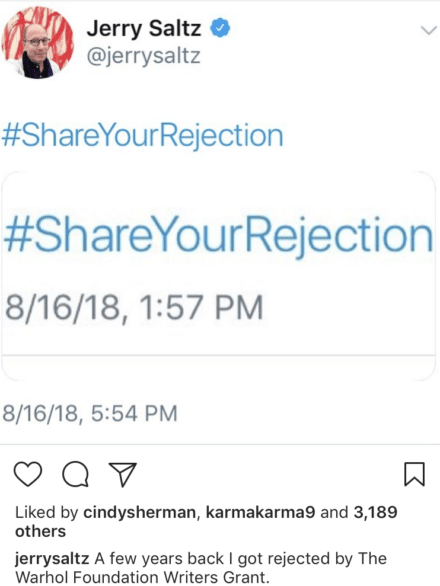Following a portfolio review, a gallerist told the artist who goes by the Instagram handle Wait What Show that “darn,” despite loving her paintings, “I don’t represent young women because they’re just going to get pregnant and stop painting.” This was not her first time hearing this. On the flip side, artist Zoë Sua kay was once told that the only reason she was offered an exhibition was because the curator found her attractive—not because of her work.
 These anecdotes and hundreds more were posted on social media in response to a request by Jerry Saltz, beloved Pulitzer Prize–winning art critic and writer, encouraging his followers to “#ShareYourRejection” under that hashtag. An artist himself, Saltz has long been an advocate for artists, giving voice to their experiences and disillusionment with the art world, and his call generated a huge response.
These anecdotes and hundreds more were posted on social media in response to a request by Jerry Saltz, beloved Pulitzer Prize–winning art critic and writer, encouraging his followers to “#ShareYourRejection” under that hashtag. An artist himself, Saltz has long been an advocate for artists, giving voice to their experiences and disillusionment with the art world, and his call generated a huge response.
Perhaps, Saltz created this hashtag because he has also, at times, been robbed of a fair shot himself, by the very club of which some would argue he is a card-carrying member (if only for the access his writing and criticism provides). In solidarity, he shared one of his own stories, writing about how he was recently rejected for an art-writer’s grant from a well-known and respected legacy artist foundation. After a bit of digging, he discovered that most of the awarded grantees had written for the same art publication at which most of the judges worked.
With similar scenarios being reported again and again by artists across the country, it’s nearly impossible to avoid the conclusion that the art market is pitted against the majority of professional working artists, and its current structure serves as a barrier to the economic stability and sustainability of working artists.
Who Measures the Value of Art?
Rejection is part and parcel of any artist’s life. But rejection that’s based on unethical bias and nepotistic-like favoritism? Well, that breeds a dangerous understanding of the art world. Is it a white-washed homogeneous club with a very limited membership that is nearly impossible to penetrate? Is it just another institution dictated by an unspoken (and systemic) sense of entitlement around the idea of ownership and exclusivity? Or is it truly a critical element of a democratic system, one that’s rooted in the belief that art should be accessible; challenge our perspectives and choices; celebrate inclusivity and diversity (artists make up the most diverse industry in the U.S.); interpret and document our shared history and individual stories; and even make us uncomfortable sometimes? What is it, exactly, that we want art to stand for?
It all seems to come back to the overarching question of who determines the value of a work of art. Who are the real purveyors of what we, as a culture, decide is worthy of adorning the walls of our most highly regarded institutions?
Whatever conclusions we ultimately draw, it’s critical that artists be part of the conversation. It’s time for them to take back some of the control and build an arts culture that is supportive of artists themselves. Because without them, there will be no art. And do we really want to live in that kind of a world?







